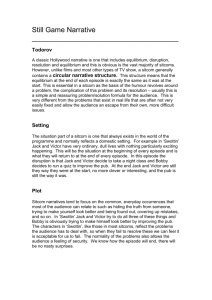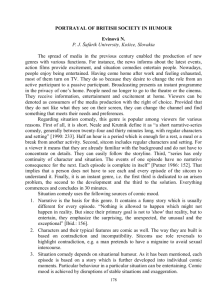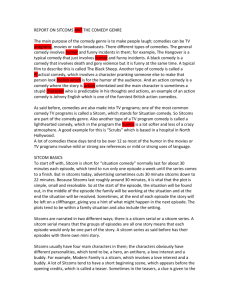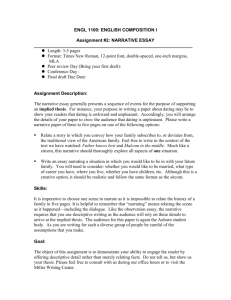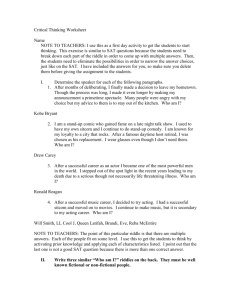TV Sitcoms and Gender
advertisement
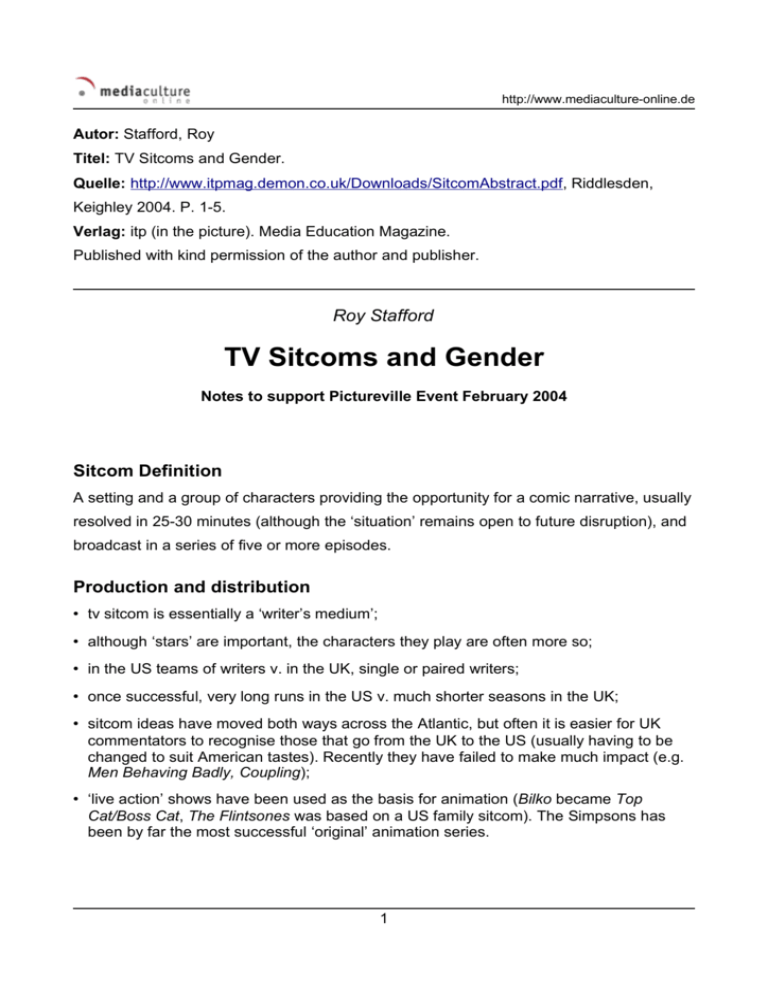
http://www.mediaculture-online.de Autor: Stafford, Roy Titel: TV Sitcoms and Gender. Quelle: http://www.itpmag.demon.co.uk/Downloads/SitcomAbstract.pdf, Riddlesden, Keighley 2004. P. 1-5. Verlag: itp (in the picture). Media Education Magazine. Published with kind permission of the author and publisher. Roy Stafford TV Sitcoms and Gender Notes to support Pictureville Event February 2004 Sitcom Definition A setting and a group of characters providing the opportunity for a comic narrative, usually resolved in 25-30 minutes (although the ‘situation’ remains open to future disruption), and broadcast in a series of five or more episodes. Production and distribution • tv sitcom is essentially a ‘writer’s medium’; • although ‘stars’ are important, the characters they play are often more so; • in the US teams of writers v. in the UK, single or paired writers; • once successful, very long runs in the US v. much shorter seasons in the UK; • sitcom ideas have moved both ways across the Atlantic, but often it is easier for UK commentators to recognise those that go from the UK to the US (usually having to be changed to suit American tastes). Recently they have failed to make much impact (e.g. Men Behaving Badly, Coupling); • ‘live action’ shows have been used as the basis for animation (Bilko became Top Cat/Boss Cat, The Flintsones was based on a US family sitcom). The Simpsons has been by far the most successful ‘original’ animation series. 1 http://www.mediaculture-online.de • US shows are ‘syndicated’ across many channels and exported worldwide; • UK production contexts changed with the advent of Channel 4 and the rise of the ‘independent producer’ (sitcoms were the basis for the rise of new companies such as Hat Trick, Celador etc.). • US sitcoms helped make big stars and also worked to ‘spin-off’ new series. The Mary Tyler Moore Show in the 1970s produced both in the 1970s produced both Rhoda (sitcom) and Lou Grant (drama). The Cosby Show made Bill Cosby the biggest star made Bill Cosby the biggest star on US TV and created A Different World. Matt LeBlanc is being ‘spun-off’ into Joey in 2004. • ‘Guest stars’ have always been an im por tant attraction in long-running US shows. Less common in the more insular UK shows. • Sitcoms have been developed into feature films, especially in the UK in the 1950s, 60s and 70s. (Kevin and Perry Go Large is a recent example of tv sitcom-type characters in a film.) Hollywood in the 1990s revived sitcom characters from the 1960s and earlier in big budget features (e.g. Sgt. Bilko (US 1996) • Feature films have also become sitcoms (M*A*S*H was a feature film before becoming a very long-running series) • Early US shows (I Love Lucy, Bilko) were shot on film, allowing export across the world and easy archiving on high quality stock. • Most early UK material was not recorded/ archived. • Most sitcoms are studio productions with a few simple sets and occasional filmed inserts. • A ‘laughter track’ from a studio audience or ‘canned’ material is often added. • Dinnerladies, with usually just the one large set is an extreme example of the studio production. • Last of the Summer Wine was unusual in shooting so much on location. • The critically-acclaimed series (The Office, The Royle Family, The Book Group) are often distinguished by camera style, film shooting, no laughter track. 2 http://www.mediaculture-online.de Narrative structure Episodes are usually presented in ‘seasons’ in the US (13 or more) and much shorter series in the UK (approx 5-7). Most sitcoms offer single episodes that are ‘self-contained’, but recently there have been more quasi ‘serial’ narratives in which a single storyline underpins the season or series. In the self-contained episode, the disruption to normality will normally be resolved by the end of the show. The most successful series are likely to be awarded a ‘special’ programme (60 mins plus). In the UK this is most likely to be a Christmas Show. Other occasional ‘special shows’ might be ‘twoparters’, holidays on location etc. The line between ‘sitcom’, drama and other TV forms is increasingly being blurred. • The Royle Family blends sitcom and soap opera, blends sitcom and soap opera, The Office is a mockumentary/spoof reality tv doc; • Alan Partridge was a character in a satire/spoof news show spun off into his own sitcom. Sometimes writers may devote an episode to a parody or a spoof of literature, fi lms etc. US series, such as Roseanne in the 1980s, have given episodes titles evoking a specific film, song etc. Narrative conventions have been borrowed from theatre (farce, comedy of manners etc.) and film. The narrative may be disrupted by contrived scenes of slapstick etc. (Noticeably in the series celebrating the antics of older characters in Dad’s Army and and Last of the Summer Wine.) Catchphrases have been important and have enabled characters to enter public discourse through mimicry. Setting and characters Possible narratives and characterisations are constrained by: • short running time (25-30 mins) • limited sets/locations • limited number of characters 3 http://www.mediaculture-online.de ‘Situation’ The single most important consideration is that the setting and the potential group of characters must offer a range of possible narrative conflicts. This is likely to mean: • characters of different ages/social background/ cultural values/personal traits; • it could, but doesn’t have to mean gender, national, regional or ethnic differences. The most common narrative situations: • ‘family’ (in the loosest sense of people living together) • workplace (office/factory) • ‘social institution’ – hospital, education, armed forces, prison etc. • leisure facility – pub, club, bar, coffee shop etc. Some of the most successful sitcoms range across both family/home and work/institution and the conflicts that arise between the two. (e.g. in Yes, Minister, the politician’s decisions are often undermined or mocked by his wife and daughter). Fawlty Towers covers both ‘home’ and ‘work’ in the same setting. Usually, however, either ‘home’ or ‘work’ are occasional settings when the other is the main focus. Conservative/Radical The sitcom is an innately conservative form (because the situation never changes and any conflict must be resolved in such a way to reproduce the potential for further conflict). Partly this is a function of scheduling in primetime for a family audience. Most sitcoms are fairly safe, but the successful ones have been seen to ‘push’ the limits. At various times One Foot in the Grave, Father Ted etc. have been seen to ‘shock’ some audiences. Sitcoms on C4 or BBC2 are more able to address taboos. Death is one of the last taboos – broken recently in C4’s The Book Group, in which a character dies from a drug overdose. 4 http://www.mediaculture-online.de Realism/fantasy Most sitcoms (The Royle Family being a major being a major exception) offer at least a slightly exaggerated representation of everyday events – as in soap opera, most events are possible in ‘real life’ but not with such intensity or frequency. Some push much further into surrealism, based either on the setting (e.g. wartime, national security etc.) or an eccentric/unusual character. This doesn’t always match with the aesthetic – Last of the Summer Wine married eccentric behaviour with naturalistic location shooting. The Royle Family is distinguished by a single studio set, but also the use of unusual framings and compositions, perhaps associated with documentary. Character ‘differences’ Gender is the crucial factor in characterisation in the majority of sitcoms. Up until the impact of feminism in the 1970s, in the UK at least, it is clear that most of the successful sitcoms featured leading male characters (Hancock, Steptoe, Dad’s Army, Till Death Do Us Part, Porridge etc.). Women were more likely to feature in ‘ensemble casts’ – The Rag Trade, Are You Being Served? This was also a function of the employment opportunities for women. Since the 1970s, women in leading roles have been more common (but the most successful comedies have tended to be based on couples rather than single women). Women have become increasingly successful as writers, but Dinnerladies is rare in maintaining a large female ensemble cast. ‘Dysfunctional families’ offer a range of narrative possibilities. Hancock and and Steptoe (both written by Galton and Simpson) largely feature ‘men without women’. Later ‘pairs of women’ would become popular in The Liver Birds and Birds of a Feather and, most significantly in Absolutely Fabulous, three generations of women in one family. The ‘normal’ family/couple offers the opportunity for equal billing for men and women (a feature of The Good Life), but, again, the most successful series have often seen one partner as the more ‘transgressive’ of male/female roles. In this respect US sitcoms have benefited from a bigger pool of major female comedians/stars, starting with Lucille Ball and moving via Mary Tyler Moore (originally part of the Dick van Dyke Show) to Roseanne Barr. Signifi cantly, these three women built up their own production companies and were able to construct and exploit their own image and narrative opportunities. Are similar 5 http://www.mediaculture-online.de female stars able to do this in 2004? Although they are perhaps more likely to be viewed as ‘comedy dramas’, series like Ally McBeal and Sex and the City have been major influences on female-centred sitcoms. Almost by definition, comic characters are flawed – comedy arises from their inability to do some things or their propensity to attempt the impossible. Classic British comedy characters are always failing (in)gloriously and the concept of ‘loser’ as hero is what often distinguishes UK and US sitcoms. We like our ‘heroes’ pompous (Fawlty, Mainwaring) or pathetic (the ‘lads’ in Men Behaving Badly) and we enjoy both their failure and occasionally the serious and tender moments (most famously the relationship between Harold and his Dad in Steptoe and Son.) Types The constraints of sitcom production and the long tradition of comedy, in literature, theatre, music hall, radio, film etc., has produced a whole set of ‘comedy types’. Media theory suggests that all characters exist somewhere on a spectrum between a ‘type’, represented through a few familiar ‘traits’ or descriptive features and a ‘fully rounded character’ or ‘individuated character’ (often argued to be found in the literary novel). In a long-running comedy series, the central characters come to be so well-known that eventually they become more like ‘rounded characters’ (i.e. with a background or ‘back story’ and a personality displaying a complex array of values and emotions). If this goes too far, however, it shifts the series into drama. Most of the time, all the characters will be based around one of three types: archetype: a type associated with very long established characters, developed in folk tales, fairy stories, myths etc. Comedic archetypes include the ‘fool’, the simpleton (now seen as a form of prejudice), the clown etc. In modern comedy it is rare to find a character who translates directly as fool or clown, but ‘archetypal elements’ are part of the make-up of many characters. stereotype: comedies rely heavily on ‘social typing’ – characters based on traits related to social class, age, gender and ethnicity. Comedy changes over time as stereotypes change. Although stereotypes originally developed as aids to market research, they have become powerful ways of defining social groups often by the dominant groups as a way of 6 http://www.mediaculture-online.de labelling the ‘others’ in society. Negative stereotypes are the source of considerable friction, especially when they can be demonstrated to encourage discrimination. Yet, there must be at least a grain of truth in the stereotype for it to gain some form of currency. Commentary on the stereotype provides sitcom with plenty of narrative conflict and if accurately observed can ‘capture’ a sense of ‘now’. The best ‘social comment sitcoms’ will undermine stereotypes and explore ‘real’ social situations and the dynamics of social interaction. generic type: because of their writing and production constraints, sitcoms will generate their own types – characters who help the 30 minute narrative to work. The American convention of the ‘guest star’ has seen a ‘transient’ character appearing in a single episode. Of the consistent characters, the one ‘normal’ character in the work group, the long suffering official who must tolerate the daft behaviour of the leading characters – these are types whose roles carry little meaning in themselves, but who are essential to the functioning of the narrative. In the traditional family sitcom, the ‘straight characters’ are often neighbours (e.g. in Keeping Up Appearances or One Foot in the Grave). In the more couple/group centred modern sitcoms such as Coupling, there is often an absence of such characters, although one character will certainly be more ‘straight’ than the others, in order to allow certain kinds of conflict to arise. Female types in sitcoms Here are some suggestions for specific female types developed across comedy and drama since the 1950s: • Matron/Working Battleaxe • Sexy assistant • Business matriarch • Woman in a Man’s World • The Vamp (1980s) • Woman in Power • Women who fight other women • Woman who who watches her ‘biological clock’ 7 http://www.mediaculture-online.de (from the Channel 4 documentary Ballbreakers (2001) Can we devise a similar list of male types? • ‘little man against the system’? • self-important man? • the would-be lothario? • the man who won’t grow up? • the man who is afraid of women? Five Key Questions about representation These questions can be applied to any text: • what strategies does the [sitcom] adopt to represent the ‘realism’ of events? What kind of world does [sitcom] construct? • how are familiar ‘types’ used as a form of shorthand to represent people? What kinds of ideas of what is ‘typical’ does the programme entertain? • who is in control of the representations in the programme – whose values and ideas are ‘spoken’? • what likelihood is there that different audiences will make different readings? • to what extent are the representations in the programme part of the struggle in the ‘real world’ to either maintain or change the power relationships between groups of people or sets of ideas and values? What is the political role of representations? (based on material from Stafford 2001) These five sets of questions (derived from Dyer (1985) indicate the complexity of any analysis of representation. In relation to ideas of audience, it is worth noting that since the move to multi-channel television in the 1990s, the big ‘event’ sitcom has ceased to command a large audience share. Sitcoms now target more defined niche audiences on a range of channels. It is more difficult for a sitcom to ‘tap into’ contemporary issues and become the subject of what is sometimes called a ‘watercooler discussion’ (i.e. something discussed at work when people meet) since a varied audience is not watching. At the same time, sitcoms are endlessly rerunning, both on mainstream television and on 8 http://www.mediaculture-online.de specialist comedy channels. In addition, videos and DVDs of popular series are also being rented and bought as a series. The social issues and social types in these programmes may be read very differently than in the first broadcast of the series. With some sitcoms, the endless repeats may allow audiences to make much deeper readings of complex characters – but they may also effectively remove characters from their social context. Questions What are your favourite sitcoms? Why do you like them? Do you identify with the characters or the situations? Or, do you simply fi nd them amusing in a more detached way? Are your favourite programmes contemporary or archive repeats? Do you think you ‘read’ the older programmes differently? Reference Richard Dyer (1985) ‘Taking popular television seriously’ in Philip Drummond and David Lusted (eds) Television and Schooling, London: BFI Extracts The examples in the presentation today are likely to be drawn from the following series (in chronological order): Hancock’s Half Hour (1956-61) (61 episodes) The first major UK television comedy ‘event’ – a ‘comedian-led’ sitcom. Steptoe and Son (1962-74, 59 episodes) First UK ‘actor-led’ sitcom. The Likely Lads (1964-6, BBC2, 20 episodes) & Whatever Happened to the Likely Lads? (1972-3) (27 episodes) Two ‘lads’ in Hartlepool written by Dick Clement and Ian le Frenais The Rag Trade (1961-3, BBC, 36 episodes), (1977-8, LWT 22 episodes) Women in a small clothing workshop 9 http://www.mediaculture-online.de Are You Being Served? (1972-84) (69 episodes) Grace Brothers’ old style department store No Problem C4/LWT / 27x30m-e / 1983-85 Four young people left behind in a Willesden house when their parents return to the West Indies. Roseanne ABC/Wind Dancer Prod./ Carsey-Werner Co/Full Moon and High Tide / 218x30m-e 2x60m-e / 1988-97 The original ‘disruptive woman’ as working mother and wife in working-class America. Desmond’s C4/HBP / 70x30m-e 1x60m-e / 1989-94 Desmond’s barbershop in Peckham A Different World NBC/Carsey-Werner/ 142x30m-e / NBC/Carsey-Werner/ 142x30me / 1x60m-e / 1987-93 A spin-off from The Cosby Show set in an African- American University sorority house Absolutely Fabulous BBC/Saunders and French prods. /24x30m-e 2x45m-e / 1992-96 and 2001/ season one BBC2 rest BBC1 I’m Alan Partridge BBC2 / 6x30m-e / 1997, 2002 Dinnerladies BBC1 / 16x30m-e / 1998-99 The Royle Family (1998-2000) (20 episodes) My Family BBC1-DLT Entertainment UK / 14x30m-e / BBC1-DLT Entertainment UK / 14x30m-e / 2000-2001 First Episode: 19 September 2000 Coupling BBC2/Hartswood Films 22x30m, 3 seasons starting 2000 The Office BBC2 / 2x6x30m / starting 9 July 2001 The Osbournes 2002 All About Me BBC1-Celador 2002- 2 seasons 2 Pints of Lager BBC2/BBC Choice/BBC 3 2001 - 3 BBC2/BBC Choice/BBC 3 2001 - 3 seasons The Book Group CH4 2002-3 - 2 seasons Source www.memorabletv.com/sitcomsw.htm www.bbc.co.uk/comedy/guide/ 10 http://www.mediaculture-online.de Other resources James Baker (2002)Teaching Film & Media Studies: TV Sit-com, BFI Jonathan Bignell (2003) An Introduction to Television Studies, Routledge Gill Branston & Roy Stafford (2002) The Media Student’s Book (3rd edition), Routledge Graeme Burton (2000) Talking Television, Arnold Vivienne Clark, James Baker, & Eileen Lewis, (2002) Key Concepts & Skills for Media Studies, Hodder/ Arnold Glen Creeber (ed.) (2001) The Television Genre Book, BFI David Gauntlett (2002) Media, Gender and Identity: An Introduction, Routledge Andrew Hirschhorn, Roy Stafford and Katy Woods (2003) ‘A Man’s World or Women on Top?’, in the picture 46, April – see www.itpmag.demon.co.uk Pat Kirkham & Beverley Skeggs (1998) ‘Absolutely Fabulous – Absolutely Feminist?’ in Geraghty and Lusted, The Television Studies Book, Arnold Nick Lacey (2000) Key Concepts in Media Studies: Image & Representation, Palgrave Roger Martin (2000) Television, Hodder David McQueen (1998) Television: A Media Student’s Guide, Arnold Toby Miller (ed) (2002) Television Studies, BFI Steve Neale & Frank Krutnik (1990) Popular Film & TV Comedy, Routledge Roy Stafford (2001) Key Concepts: Representation, BFI/itp TV programmes Ballbreakers, C4 2001 Laughter in the House, A History of British Sitcoms, BBC 1999 The Sitcom Story, BBC1 2003 11 http://www.mediaculture-online.de Das Werk einschließlich aller seiner Teile ist urheberrechtlich geschützt. Jede Verwertung außerhalb der engen Grenzen des Urheberrechtsgesetzes ist ohne Zustimmung des Rechteinhabers unzulässig und strafbar. Das gilt insbesondere für Vervielfältigungen, Übersetzungen, Mikroverfilmungen und die Speicherung und Verarbeitung in elektronischen Systemen. 12
